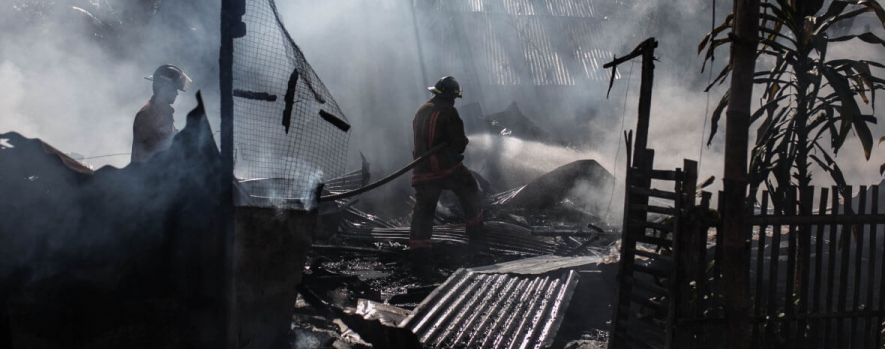
PPE AND PROTECTIVE CLOTHING FOR FIRE DAMAGE CLEAN UP
The men and women who fight fires to protect their communities are true heroes. They put their lives and health at risk in order to perform their jobs and save lives during the clean-up and recovery process.
Unfortunately, the dangers of firefighting don't end when the fire is out. Determining and implementing the appropriate protocols for worker safety during fire cleanup, such as the use of personal protective equipment (PPE), can help these critical workers prepare for fire season or a public evacuation order.
This is essential to protect anyone who may be affected or involved by a structural fire or wildfire—including volunteers, emergency medical technicians, paramedics, police officers, and even homeowners who must return to their residences and begin the challenging process of recovery and rebuilding.
The Risks of Wildfire and Fire Cleanup Work
Debris and waste kicked up during wildfires can pose a serious threat to the health and safety of exposed individuals, especially if they are unprotected. When cleaning up fire-damaged structures, elements of the building itself must be considered, including the age of the home, the materials with which the building was made, as well as whether there were any chemicals present in the house which may have been released or affected by the fire.
A few of the most common occupational hazards of fire debris clean up that may be present, especially in buildings and homes built prior to the 1980s, include:
- Asbestos (in insulation)
- Lead (in paint)
- Polychlorinated biphenyl (PCB) (in caulk)
- Household chemicals, including cleaners, pesticides, paints, and fuels such as gasoline, kerosene, or propane
- Mold and mold spores (common on certain types of carpets, vinyl wall coverings, and wood and drywall)
Without adequate PPE, a person involved in the cleanup of a structure ravaged by fire is at risk for inhalation, ingestion,or physical contact with any of these harmful substances. Burns, accidental poisoning, excessive carbon monoxide exposure (CO), and even long-term health consequences can occur with enough exposure.
Additional risks during the clean-up process after fires include:
- Encountering active fire
- Exposure to hot structures and substances that can cause thermal or chemical burns
- Flammable gases
- Inhalation/ingestion of or physical contact with vapors, ash, demolition dust, soot, ash, disinfectants, cleaners, etc.
- Excessive exposure to carbon monoxide while using equipment such as pressure washers and generators in poorly ventilated areas
- Confined spaces where noxious gas concentrations are higher due to poor ventilation
- Exposure to electrical equipment can result in electrocution or electrical shock. This can occur in many ways such as damaged electrical systems, energized downed power lines, overhead power lines that energize materials they touch, smoke that is charged and conducts electricity, water on or near energized power lines and equipment
- Heat stress and cold stress
- Slips, trips, and falls due to unstable structures and surfaces, slippery surfaces, high surfaces, or uneven terrain (often exacerbated by poor visibility)
- The risk of engulfment, structural collapse, and other accidents
- Musculoskeletal stress due to frequent lifting, bending, twisting, or awkward postures
This list is not all-inclusive, and of course, even the best PPE protocol cannot necessarily offer 100% prevention of these hazardous situations and hazardous materials. But there are several things quality PPE can do that can maximize the ability of first responders and other workers to remain safe while performing their important duties.
What PPE to Consider for Occupational Hazards of Fire Debris Clean Up
Personal protective equipment during fire cleanup operations must include several protective aspects. First, gear should be available that protects the head, face, and eyes to prevent inhalation or absorption of harmful substances. This may include hard hats, face shields,and goggles.
Hearing protection is indicated in the event that employees are working in loud environments and/or utilizing loud equipment to disassemble structures or for heavy lifting operations.
Respiratory protection for both the professional and layman is often required. For the professional cleanup workers, respirator programs must be in place from the employer to ensure proper training, selection, fit testing, maintenance, and inspection.
Additional "head to toe" protection is necessary in order to minimize skin contact, improve worker visibility, maintain worker comfort and mobility, and decrease the risk of electrical or chemical burns. To this end, coveralls, gloves, steel toe boots, and shoe or boot covers are essential.
PPE must also be conducive to worker comfort and safety, especially in the setting of fall prevention and fall protection. Firefighters and other members of a wildfire cleanup operation are often working on unstable surfaces at a great height and may require the use of harnesses, lanyards, and other safety measures. PPE must accommodate these extra preventive elements while at the same time affording adequate movement and comfort for the worker.
Using disposable protective clothing is beneficial in this case for several reasons: it's cost-effective, easy to transport and disperse, protects more costly under-garments, adds an extra layer of protection in addition to primary PPE, and lastly, it can reduce the risk of further community exposure through take-home hazards. Individuals wearing disposable PPE can simply discard the apparel after use, rather than having to launder it.
MicroGuard MP® from International Enviroguard is a leading choice for wildfire clean-up and fire damage recovery. Our garments (which include coveralls, coats, boot covers, and shoe covers) feature a high moisture vapor transmission rate (MVTR) and excellent liquid/spray/particulate barrier capability.
Protect Your Employees,Your Community, and Your Financial Bottom Line
Is your company involved in fire recovery and clean-up? We're here to help decrease workers' exposure to hazardous materials while on the job. Our knowledgeable and passionate team of PPE experts is standing by and ready to help you find the perfect protective apparel solutions.